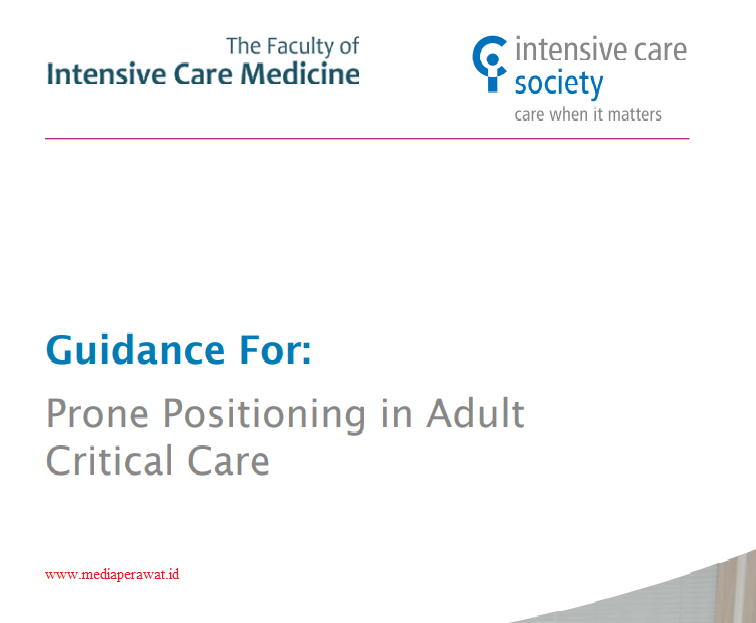Berikut daftar isinya :
- Introduction
- LocSSIP for Proning in Critical Care
- Proning Protocol
a. Indications
b. Contraindications
c. Equipment
d. Preparation - Procedures
a. Supine to Prone
b. Prone to Supine - Nursing guidance for maintaining the patient in the prone
position to prevent complications - Special Circumstances
a. Prone positioning on ECMO
b. Flexible Bronchoscopy in the Prone Position - Cardiac arrest in the prone position
Chest Compressions
Defibrillation
Appendix 1.
LocSSIP for Proning in Critical Care
Appendix 2.
Post Proning Nursing Checklist
Appendix 3.
Prone Cardiac Arrest Flowchart
BACA JUGA : Highlights of the 2020 AHA Guidelines Update for CPR and ECC
1. Introduction
Over the last two decades randomised controlled trials have consistently demonstrated that oxygenation can be significantly improved in patients with acute respiratory distress syndrome (ARDS) when ventilated in the prone position. (1-5) Early trials of prone ventilation failed to demonstrate any impact on mortality, although these trials were conducted in an era prior to lung protective ventilation, often had patients proned for short periods and included patients with mild ARDS. (1,2) As trial design evolved to include modern ventilation practices along with patients with more severe ARDS, evidence emerged that the early application of prolonged prone positioning may significantly decrease mortality compared to conventional supine ventilation. (5)
This stance has been further supported by a recent meta-analysis that concludes mechanical ventilation in the prone position significantly reduces mortality in patients with moderate to severe ARDS when used early and for greater than 16 hours per day in patients receiving lung protective ventilation. (6) In addition, a Cochrane systematic review published in 2015 recommends that prone ventilation for 16 or more hours per day should be actively considered in patients with severe
hypoxaemia within 48 hours of mechanical ventilation. (7) This has also led to the inclusion of prone ventilation in the ARDS guidance published by the Intensive Care Society (ICS) and Faculty of Intensive Care Medicine (FICM). (8)
These recommendations would suggest the use of early prone ventilation for moderate to severe hypoxaemia and potentially an increase in the number of patients that should be considered for proning. The increase in use of the prone position in critical care may have been partially responsible for a spike in critical incidents reported to NHSi over recent years. At the end of 2017,
NHSi approached the ICS/FICM Joint Standards Committee (JSC), keen to draw our attention to this increase in incidents and with the hope that the committee might identify a strategy to reduce the number of incidents moving forward.
With this in mind the ICS/FICM JSC performed a national survey of its members to identify current practices across the UK and to identify whether there was a need for a national guidance on managing patients in the prone position.
The survey confirmed that 80% of respondents would routinely prone a patient with refractory hypoxia, intimating that there has been widespread acceptance of prone ventilation as a treatment strategy in these circumstances. Interestingly the survey identified that only 30% of respondents worked within a unit that used a specific prone ventilation protocol/checklist to facilitate the procedure of turning a patient prone. Only 58% of units used a post-proning protocol or guidance regarding how to nurse patients in this often, unfamiliar position. Surveyed members reported personal experience with wide array of complications including;
Pressure sores (most cited injury)
• Facial / periorbital oedema
• IV line / ETT displacement
• CVS instability
• Ocular injury/corneal abrasions
• Brachial plexus injury
• Staff injury
• CRRT line flow problems
Most of these complications are preventable and it is hoped that the adoption of the guidance set out within this document will help improve safety and reduce complications associated with the prone positioning of mechanically ventilated patients. This document also hopes to standardise the approach to manging a cardiac arrest in the prone position, and has some guidance on prone ventilation in ECMO patients as well as considerations for performing bronchoscopy in the prone position. Assuming adequate staffing and equipment is available, the intervention of prone
positioning involves very low costs and provided additional patient complications and long-term injuries to staff do not occur, would almost certainly be a cost-effective intervention. (7)
BACA JUGA : Standar Kompetensi Perawat ICU
References
- Gattinoni, L., Tognoni, G., Pesenti, A. et al. Effect of Prone Positioning on the Survival of
Patients with Acute Respiratory Failure. N Engl J Med (2001); 345 (8): 568-573. - Geurin, C., Gaillard, S., Lemasson, S. Effects of Systematic Prone Positioning in
Hypoxaemic Acute Respiratory Failure. JAMA (2004); 292: 2379-2387. - Mancebo, J., Fernández, R., Blanch L. et al. A Multicenter Trial of Prolonged Prone
Ventilation in Severe Acute Respiratory Distress Syndrome. Am J Respir Crit Care Med
(2006); 173: 1233–1239. - Taccone, P., Pesenti, A., Latini, R. et al. Prone–Supine II Study Group. Prone Positioning in
Patients with Moderate and Severe Acute Respiratory Distress Syndrome: A Randomized
Controlled Trial. JAMA (2009); 302: 1977–1984. - Guérin, C., Reignier, J., Richard, JC. Et al. PROSEVA Study Group. Prone Positioning in
Severe Acute Respiratory Distress Syndrome. N Engl J Med (2013); 368: 2159–2168. - Sud, S., Friedrich, J., Adhikari, N. et al. Effect of prone positioning during mechanical
ventilation on mortality among patients with acute respiratory distress syndrome: a
systematic review and meta-analysis. CMAJ (2014); 186 (10): 381-390. - Bloomfield, R., Noble, D., Sudlow, A. (2015) Prone position for acute respiratory failure in
adults. Cochrane database of systematic reviews. CD008095.pub2 - Guidelines on the management of the Acute Respiratory Distress Syndrome. Version 1 July
- Faculty of Intensive Care Medicine and Intensive Care Society
untuk materi lengkap klik Download
BACA JUGA : Highlights of the 2020 AHA Guidelines Update for CPR and ECC
BACA JUGA : Standar Kompetensi Perawat ICU
BACA JUGA : 5 Cara Cepat Belajar Membaca EKG Dasar
